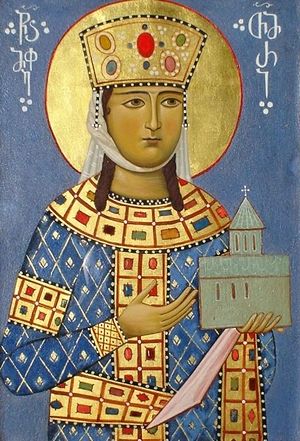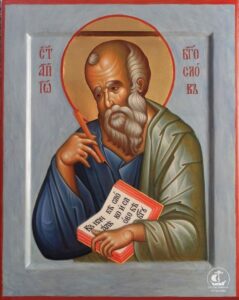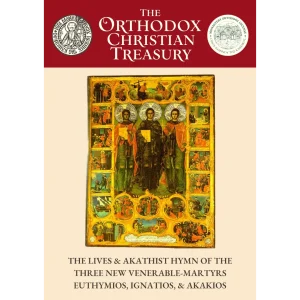St. Tamara, Queen of Georgia

Commemorated on May 1 and on the Sunday of Myrrh-Bearing Women
In 1166 a daughter, Tamar, was born to King George III (1155–1184) and Queen Burdukhan of Georgia. The king proclaimed that he would share the throne with his daughter from the day she turned twelve years of age.
The royal court unanimously vowed its allegiance and service to Tamar, and father and daughter ruled the country together for five years. After King George’s death in 1184, the nobility recognized the young Tamar as the sole ruler of all Georgia. Queen Tamar was enthroned as ruler of all Georgia at the age of eighteen. She is called “King” in the Georgian language because her father had no male heir and so she ruled as a monarch and not as a consort.
At the beginning of her reign, Tamar convened a Church council and addressed the clergy with wisdom and humility: “Judge according to righteousness, affirming good and condemning evil,” she advised. “Begin with me–if I sin I should be censured, for the royal crown is sent down from above as a sign of divine service. Allow neither the wealth of the nobles nor the poverty of the masses to hinder your work. You by word and I by deed, you by preaching and I by the law, you by upbringing and I by education will care for those souls whom God has entrusted to us, and together we will abide by the law of God, in order to escape eternal condemnation…. You as priests and I as ruler, you as stewards of good and I as the watchman of that good.”
The Church and the royal court chose a suitor for Tamar: Yuri, the son of Prince Andrei Bogoliubsky of Vladimir-Suzdal (in Georgia Yuri was known as “George the Russian”). The handsome George Rusi was a valiant soldier, and under his command the Georgians returned victorious from many battles. His marriage to Tamar, however, exposed many of the coarser sides of his character. He was often drunk and inclined toward immoral deeds. In the end, Tamar’s court sent him away from Georgia to Constantinople, armed with a generous recompense. Many Middle Eastern rulers were drawn to Queen Tamar’s beauty and desired to marry her, but she rejected them all. Finally at the insistence of her court, she agreed to wed a second time to ensure the preservation of the dynasty. This time, however, she asked her aunt and nurse Rusudan (the sister of King George III) to find her a suitor. The man she chose, Davit-Soslan Bagrationi, was the son of the Ossetian ruler and a descendant of King George I (1014-1027).
In 1195 a joint Muslim military campaign against Georgia was planned under the leadership of Atabeg (a military commander) Abu Bakr of Persian Azerbaijan. At Queen Tamar’s command, a call to arms was issued. The faithful were instructed by Metropolitan Anton of Chqondidi to celebrate All-night Vigils and Liturgies and to generously distribute alms so that the poor could rest from their labors in order to pray. In ten days the army was prepared, and Queen Tamar addressed the Georgian soldiers for the last time before the battle began. “My brothers! Do not allow your hearts to tremble before the multitude of enemies, for God is with us…. Trust God alone, turn your hearts to Him in righteousness, and place your every hope in the Cross of Christ and in the Most Holy Theotokos!” she exhorted them.
Having taken off her shoes, Queen Tamar climbed the hill to the Metekhi Church of the Theotokos (in Tbilisi) and knelt before the icon of the Most Holy Theotokos. She prayed without ceasing until the good news arrived: the battle near Shamkori had ended in the unquestionable victory of the Orthodox Georgian army.
After this initial victory the Georgian army launched into a series of triumphs over the Turks, and neighboring countries began to regard Georgia as the protector of the entire Transcaucasus. By the beginning the 13th century, Georgia was commanding a political authority recognized by both the Christian West and the Muslim East.
Georgia’s military successes alarmed the Islamic world. Sultan Rukn al-Din was certain that a united Muslim force could definitively decide the issue of power in the region, and he marched on Georgia around the year 1203, commanding an enormous army.
Having encamped near Basiani, Rukn al-Din sent a messenger to Queen Tamar with an audacious demand: to surrender without a fight. In reward for her obedience, the sultan promised to marry her on the condition that she embrace Islam; if Tamar were to cleave to Christianity, he would number her among the other unfortunate concubines in his harem. When the messenger relayed the sultan’s demand, a certain nobleman, Zakaria Mkhargrdzelidze, was so outraged that he slapped him on the face, knocking him unconscious.
At Queen Tamar’s command, the court generously bestowed gifts upon the ambassador and sent him away with a Georgian envoy and a letter of reply. “Your proposal takes into consideration your wealth and the vastness of your armies, but fails to account for divine judgment,” Tamar wrote, “while I place my trust not in any army or worldly thing but in the right hand of the Almighty God and the infinite aid of the Cross, which you curse. The will of God–and not your own–shall be fulfilled, and the judgment of God–and not your judgment–shall reign!”
The Georgian soldiers were summoned without delay. Queen Tamar prayed for victory before the Vardzia Icon of the Theotokos, then, barefoot, led her army to the gates of the city.
Hoping in the Lord and the fervent prayers of Queen Tamar, the Georgian army marched toward Basiani. The enemy was routed. The victory at Basiani was an enormous event not only for Georgia, but for the entire Christian world.
The military victories increased Queen Tamar’s faith. In the daytime she shone in all her royal finery and wisely administered the affairs of the government; during the night, on bended knees, she beseeched the Lord tearfully to strengthen the Georgian Church. She busied herself with needlework and distributed her embroidery to the poor.
Once, exhausted from her prayers and needlework, Tamar dozed off and saw a vision. Entering a luxuriously furnished home, she saw a gold throne studded with jewels, and she turned to approach it, but was suddenly stopped by an old man crowned with a halo. “Who is more worthy than I to receive such a glorious throne?” Queen Tamar asked him.
He answered her, saying, “This throne is intended for your maidservant, who sewed vestments for twelve priests with her own hands. You are already the possessor of great treasure in this world.” And he pointed her in a different direction.
Having awakened, Holy Queen Tamar immediately took to her work and with her own hands sewed vestments for twelve priests.
History has preserved another poignant episode from Queen Tamar’s life: Once she was preparing to attend a festal Liturgy in Gelati, and she fastened precious rubies to the belt around her waist. Soon after she was told that a beggar outside the monastery tower was asking for alms, and she ordered her entourage to wait. Having finished dressing, she went out to the tower but found no one there. Terribly distressed, she reproached herself for having denied the poor and thus denying Christ Himself. Immediately she removed her belt, the cause of her temptation, and presented it as an offering to the Gelati Icon of the Theotokos.
During Queen Tamar’s reign a veritable monastic city was carved in the rocks of Vardzia, and the God-fearing Georgian ruler would labor there during the Great Fast. The churches of Pitareti, Kvabtakhevi, Betania, and many others were also built at that time. Holy Queen Tamar generously endowed the churches and monasteries not only on Georgian territory but also outside her borders: in Palestine, Cyprus, Mt. Sinai, the Black Mountains, Greece, Mt. Athos, Petritsoni (Bulgaria), Macedonia, Thrace, Romania, Isauria and Constantinople. The divinely guided Queen Tamar abolished the death penalty and all forms of bodily torture.
A regular, secret observance of a strict ascetic regime–fasting, a stone bed, and litanies chanted in bare feet–finally took its toll on Queen Tamar’s health. For a long time she refrained from speaking to anyone about her condition, but when the pain became unbearable she finally sought help. The best physicians of the time were unable to diagnose her illness, and all of Georgia was seized with fear of disaster. Everyone from the small to the great prayed fervently for Georgia’s ruler and defender. The people were prepared to offer not only their own lives, but even the lives of their children, for the sake of their beloved ruler.
God sent Tamar a sign when He was ready to receive her into His Kingdom. Then the pious ruler bade farewell to her court and turned in prayer to an icon of Christ and the Life-giving Cross: “Lord Jesus Christ! Omnipotent Master of heaven and earth! To Thee I deliver the nation and people that were entrusted to my care and purchased by Thy Precious Blood, the children whom Thou didst bestow upon me, and to Thee I surrender my soul, O Lord!”
The burial place of Queen Tamar has remained a mystery to this day. Some sources claim that her tomb is in Gelati, in a branch of burial vaults belonging to the Bagrationi dynasty, while others argue that her holy relics are preserved in a vault at the Holy Cross Monastery in Jerusalem.
St. Tamara is commemorated on the Sunday of the Myrrh-bearing Women in addition to her regular commemoration on May 1.
© 2006 St. Herman of Alaska Brotherhood.






